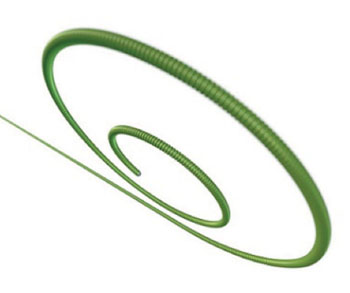Pre-Shaped Guidewire Sized for Smaller Ventricles
By HospiMedica International staff writers
Posted on 04 Aug 2015
An enhanced version of the Safari guidewire facilitates the introduction and placement of interventional devices within the heart. Posted on 04 Aug 2015
The Boston Scientific Safari2 pre-shaped guidewire is designed to offer streamlined device delivery with enhanced wire predictability and shape retention for placing interventional devices within the heart, including those used with transcatheter aortic valve implantation or replacement procedures (TAVI/R). The Safari2 product line offers a wide choice with three curve sizes, including a new extra small curve designed for procedures involving patients with smaller ventricles. Prior to the Safari guidewire, physicians used peripheral intervention guidewires manually shaped for TAVI procedures.

Image: The Boston Scientific Safari2 pre-shaped guidewire (Photo courtesy of Boston Scientific).
The Safari2 Guidewire is designed to complement the Boston Scientific Lotus Valve System, a next-generation TAVI/R device designed to give physicians more control throughout the procedure. The Lotus Valve System offers an alternative treatment for patients with severe aortic stenosis who are at high risk for surgical valve replacement. The Safari and Safari2 guidewires and the Lotus Valve System are products of Boston Scientific (Natick, MA, USA), and have received the European Community CE marking of approval. They are distributed separately.
“The Safari2 Guidewire reflects our dedication and our commitment to meaningful innovation in the treatment of structural heart disorders,” said Tom Fleming, vice president and general manager of the structural heart division at Boston Scientific. “We will continue to invest in technologies like Safari2 which facilitate successful TAVI/R outcomes and improve quality of life for patients with valvular disease worldwide.”
“Having a pre-shaped, universal TAVR guidewire helps physicians deliver the replacement valve with reliability and consistency,” commented Wesley Pederson, MD, director of valve and structural heart disease at the Minneapolis Heart Institute Foundation (MHIF; MN, USA; www.mplsheart.org). “This is a wonderful development to have a smaller curve size so that we can offer this less invasive treatment option to a broader range of patients, because valvular disease can have a devastating impact on patient survival and quality of life.”
TAVI involves the percutaneous insertion of a catheter containing a replacement valve at a site in the groin or the left chest. The new valve is pushed into the correct site where the surgeon expands it and pushes the old one aside. The procedure is much less invasive than traditional open heart aortic valve replacement and does not require putting the patient on a heart and lung machine, so it can be performed on those who cannot have open heart surgery.
Related Links:
Boston Scientific














